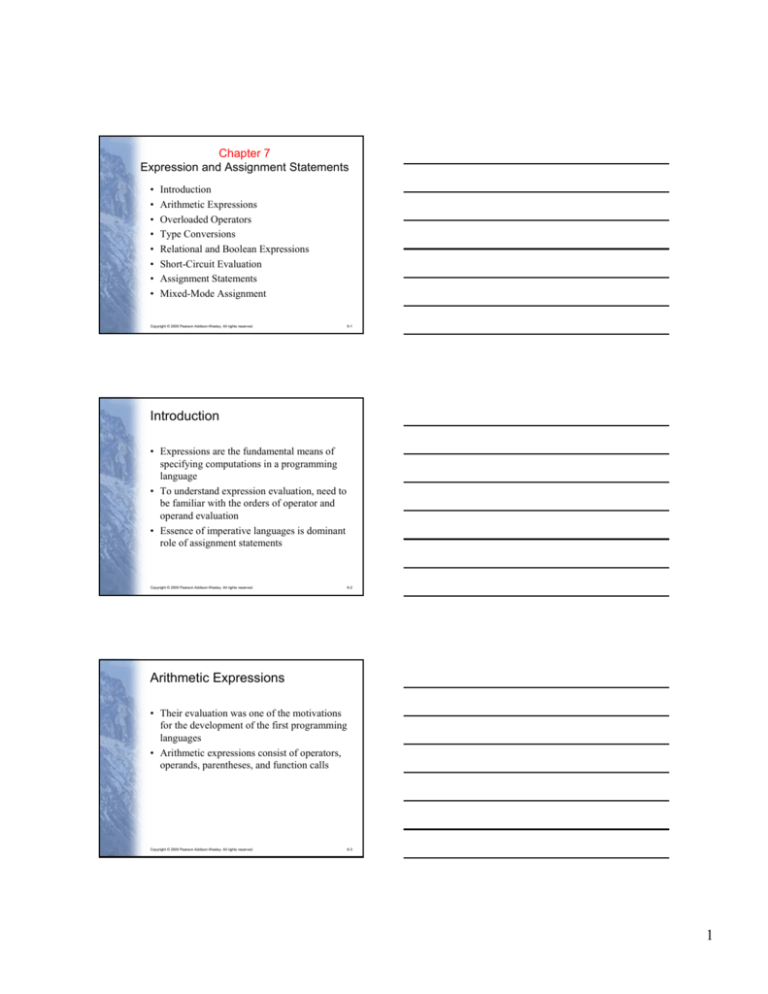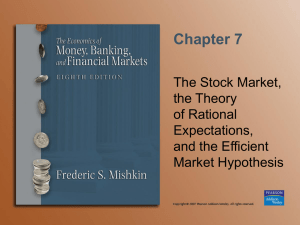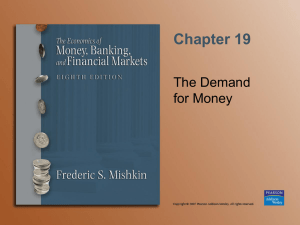
Chapter 7
Expression and Assignment Statements
•
•
•
•
•
•
•
•
Introduction
Arithmetic Expressions
Overloaded Operators
Type Conversions
Relational and Boolean Expressions
Short-Circuit Evaluation
Assignment Statements
Mixed-Mode Assignment
Copyright © 2006 Pearson Addison-Wesley. All rights reserved.
6-1
Introduction
• Expressions are the fundamental means of
specifying computations in a programming
language
• To understand expression evaluation, need to
be familiar with the orders of operator and
operand evaluation
• Essence of imperative languages is dominant
role of assignment statements
Copyright © 2006 Pearson Addison-Wesley. All rights reserved.
6-2
Arithmetic Expressions
• Their evaluation was one of the motivations
for the development of the first programming
languages
• Arithmetic expressions consist of operators,
operands, parentheses, and function calls
Copyright © 2006 Pearson Addison-Wesley. All rights reserved.
6-3
1
Arithmetic Expressions
• Design issues for arithmetic expressions:
1. What are the operator precedence rules?
2. What are the operator associativity rules?
3. What is the order of operand evaluation?
4. Are there restrictions on operand evaluation side
effects?
5. Does the language allow user-defined operator
overloading?
6. What mode mixing is allowed in expressions?
Copyright © 2006 Pearson Addison-Wesley. All rights reserved.
6-4
Arithmetic Expressions
• A unary operator has one operand
• A binary operator has two operands
• A ternary operator has three operands
Copyright © 2006 Pearson Addison-Wesley. All rights reserved.
6-5
Arithmetic Expressions
• Def: The operator precedence rules for expression
evaluation define the order in which “adjacent”
operators of different precedence levels are
evaluated (“adjacent” means they are separated by
at most one operand)
• Typical precedence levels
1. parentheses
2. unary operators
3. ** (if the language supports it)
4. *, /
5. +, Copyright © 2006 Pearson Addison-Wesley. All rights reserved.
6-6
2
Arithmetic Expressions
• Def: The operator associativity rules for expression
evaluation define the order in which adjacent
operators with the same precedence level are
evaluated
• Typical associativity rules:
– Left to right, except **, which is right to left
– Sometimes unary operators associate right to left (e.g.,
FORTRAN)
• APL is different; all operators have equal precedence
and all operators associate right to left
• Precedence and associativity rules can be overriden
with parentheses
Copyright © 2006 Pearson Addison-Wesley. All rights reserved.
6-7
Arithmetic Expressions
• Operand evaluation order
– The process:
1. Variables: just fetch the value
2. Constants: sometimes a fetch from memory;
sometimes the constant is in the machine language
instruction
3. Parenthesized expressions: evaluate all operands
and operators first
4. Function references: The case of most interest
• Order of evaluation is crucial
Copyright © 2006 Pearson Addison-Wesley. All rights reserved.
6-8
Arithmetic Expressions
• Functional side effects - when a function changes a
two-way parameter or a nonlocal variable
• The problem with functional side effects:
– When a function referenced in an expression alters another
operand of the expression; e.g., for a parameter change:
a = 10;
b = a + fun(&a);
/* Assume that fun changes its
parameter */
– Same problem with global variables
Copyright © 2006 Pearson Addison-Wesley. All rights reserved.
6-9
3
Functional Side Effects
• Two Possible Solutions to the Problem:
1. Write the language definition to disallow
functional side effects
– No two-way parameters in functions
– No nonlocal references in functions
– Advantage: it works!
– Disadvantage: Programmers want the flexibility of
two-way parameters (what about C?) and nonlocal
references
Copyright © 2006 Pearson Addison-Wesley. All rights reserved.
6-10
Functional Side Effects
• Two Possible Solutions to the Problem
(continued):
2. Write the language definition to demand that
operand evaluation order be fixed
– Disadvantage: limits some compiler optimizations
Copyright © 2006 Pearson Addison-Wesley. All rights reserved.
6-11
Arithmetic Expressions
• Conditional Expressions allowed?
– C, C++, and Java (?:)
e.g.
average = (count == 0)? 0 : sum / count
Copyright © 2006 Pearson Addison-Wesley. All rights reserved.
6-12
4
Overloaded Operators
• Def: use of an operator for more than one
purpose is called operator overloading
– Some are common (e.g., + for int and float)
– Some are potential trouble (e.g., * in C and C++)
– Loss of compiler error detection (omission of an
operand should be a detectable error, e.g. unarybinary-)
– Some loss of readability
– Can be avoided by introduction of new symbols
(e.g., Pascal’s div)
Copyright © 2006 Pearson Addison-Wesley. All rights reserved.
6-13
Overloaded Operators
• C++ and Ada allow user-defined overloaded
operators
• Potential problems:
– Users can define nonsense operations
– Readability may suffer, even when the operators
make sense
Copyright © 2006 Pearson Addison-Wesley. All rights reserved.
6-14
Type Conversions
• Def: A narrowing conversion is one that
converts an object to a type that cannot
include all of the values of the original type
e.g., float to int
• Def: A widening conversion is one in which
an object is converted to a type that can
include at least approximations to all of the
values of the original type
e.g., int to float
Copyright © 2006 Pearson Addison-Wesley. All rights reserved.
6-15
5
Type Conversions
• Def: A mixed-mode expression is one that has
operands of different types
• Def: A coercion is an implicit type conversion
• The disadvantage of coercions:
– They decrease the type error detection ability of the compiler
• In most languages, all numeric types are coerced in
expressions, using widening conversions
• In Ada, there are virtually no coercions in expressions
Copyright © 2006 Pearson Addison-Wesley. All rights reserved.
6-16
Type Conversions
• Explicit Type Conversions
• Often called casts
e.g.
Ada:
FLOAT(INDEX)--INDEX is INTEGER type
Java:
(int)speed
/*speed is float type*/
Copyright © 2006 Pearson Addison-Wesley. All rights reserved.
6-17
Type Conversions
• Errors in Expressions
• Caused by:
– Inherent limitations of arithmetic
e.g. division by zero
– Limitations of computer arithmetic
e.g. overflow
Copyright © 2006 Pearson Addison-Wesley. All rights reserved.
6-18
6
Relational and Boolean
Expressions
• Relational Expressions:
– Use relational operators and operands of various
types
– Evaluate to some Boolean representation
– Operator symbols used vary somewhat among
languages (!=, /=, .NE., <>, #)
Copyright © 2006 Pearson Addison-Wesley. All rights reserved.
6-19
Relational and Boolean
Expressions
• Boolean Expressions
– Operands are Boolean and the result is Boolean
Operators:
FORTRAN 77 FORTRAN 90
.AND.
.OR.
.NOT.
and
or
not
Copyright © 2006 Pearson Addison-Wesley. All rights reserved.
C
&&
||
!
Ada
and
or
not
xor
6-20
Relational and Boolean
Expressions
• C has no Boolean type--it uses int type with 0
for false and nonzero for true
• One odd characteristic of C’s expressions:
a < b < c is a legal expression, but the
result is not what you might expect
Copyright © 2006 Pearson Addison-Wesley. All rights reserved.
6-21
7
Short Circuit Evaluation
• Don’t evaluate the full expression if no need
– 4* x * Y(x) * z%m => eval if x=0?
• Suppose Java did not use short-circuit
evaluation
Problem: table look-up
index = 1;
while (index <= length) &&
(mytable[index] != value)
index++;
Both the expressions (index<=length)
and (mytable[index] != value)
evaluated => out of bound error /
Copyright © 2006 Pearson Addison-Wesley. All rights reserved.
6-22
Short Circuit Evaluation
• C, C++, and Java: use short-circuit evaluation for the
usual Boolean operators (&& and ||), but also
provide bitwise Boolean operators that are not short
circuit (& and |)
• Ada: programmer can specify either (short-circuit is
specified with and then and or else)
• FORTRAN 77: short circuit, but any side-affected
place must be set to undefined
• Short-circuit evaluation exposes the potential problem
of side effects in expressions
e.g. (a <= b) || (b++ / 3)
=> b is changed onlyif a>b /
Copyright © 2006 Pearson Addison-Wesley. All rights reserved.
6-23
Assignment Statements
• The operator symbol:
= FORTRAN, BASIC, PL/I, C, C++, Java
:= ALGOLs, Pascal, Ada
• = Can be bad if it is overloaded for the
relational operator for equality
e.g. (PL/I) A = B = C;
• Note difference from C
(uses = =)
Copyright © 2006 Pearson Addison-Wesley. All rights reserved.
6-24
8
Assignment Statements
• More complicated assignments:
1. Multiple targets (PL/I)
A, B = 10
2. Conditional targets (C, C++, and Java)
(first==true)? total : subtotal = 0
3. Compound assignment operators (C, C++, and Java)
sum += next;
Copyright © 2006 Pearson Addison-Wesley. All rights reserved.
6-25
Assignment Statements
• More complicated assignments (continued):
4. Unary assignment operators (C, C++, and Java)
a++;
C, C++, and Java treat = as an arithmetic binary
operator
e.g.
a = b * (c = d * 2 + 1) + 1
This is inherited from ALGOL 68
Copyright © 2006 Pearson Addison-Wesley. All rights reserved.
6-26
Assignment Statements
• Assignment as an Expression
– In C, C++, and Java, the assignment statement
produces a result
– So, they can be used as operands in expressions
e.g.
while ((ch = getchar())!=EOF){…}
– Disadvantage
• Another kind of expression side effect
Copyright © 2006 Pearson Addison-Wesley. All rights reserved.
6-27
9
Mixed-Mode Assignment
• In FORTRAN, C, and C++, any numeric value
can be assigned to any numeric scalar variable;
whatever conversion is necessary is done
• In Pascal, integers can be assigned to reals, but
reals cannot be assigned to integers (the
programmer must specify whether the conversion
from real to integer is truncated or rounded)
• In Java, only widening assignment coercions are
done
• In Ada, there is no assignment coercion
Copyright © 2006 Pearson Addison-Wesley. All rights reserved.
6-28
Chapter 8
Statement-Level Control Structures
•
•
•
•
•
•
Introduction
Selection Statements
Iterative Statements
Unconditional Branching
Guarded Commands
Conclusions
Copyright © 2006 Pearson Addison-Wesley. All rights reserved.
6-29
PQ2
1. Find a CFG to generate all strings of 0s and 1s that
end with 0 (i.e., regEx {0, 1}*0 )
2. What language does the following CFG recognize
S -> a S c | B
B -> b B c | €
3. Write a CFG for compound statements in C/C++
4. What language does the following CFG recognize:
S -> L | L A2
A2 -> L | D | L A3 | D A3
A3 -> L | D | L A4 | D A4
A4 -> L | D | L A5 | D A5
A5 -> L | D | L A6 | D A6
A6 -> L | D
L -> A | B | … | Z
D -> 0 | 1 | … | 9
Copyright © 2006 Pearson Addison-Wesley. All rights reserved.
6-30
10
Introduction
• Levels of Control Flow:
1. Within expressions
2. Among program units
3. Among program statements
Copyright © 2006 Pearson Addison-Wesley. All rights reserved.
6-31
Introduction
• Evolution:
– FORTRAN I control
statements were based
directly on IBM 704
hardware
– Much research and
argument in the 1960s
about the issue
– One important result: It was
proven that all flowcharts
can be coded with only
two-way selection and
pretest logical loops
Copyright © 2006 Pearson Addison-Wesley. All rights reserved.
6-32
Introduction
• Def: A control structure is a control statement
and the statements whose execution it controls
• Overall Design Question:
– What control statements should a language have,
beyond selection and pretest logical loops?
Copyright © 2006 Pearson Addison-Wesley. All rights reserved.
6-33
11
Selection Statements
• A selection statement provides the means of
choosing between two or more paths of
execution
• Two general categories:
– Two-way selectors
– Multiple-way selectors
Copyright © 2006 Pearson Addison-Wesley. All rights reserved.
6-34
Two-Way Selection Statements
• Design Issues:
1. What is the form and type of the control
expression?
2. How are the then and else clauses specified?
3. How should the meaning of nested selectors be
specified?
Copyright © 2006 Pearson Addison-Wesley. All rights reserved.
6-35
Two-Way Selection Statements
• Examples
– FORTRAN IF: IF (boolean_expr) statement
– Problem: can select only a single statement; to
select more, a GOTO must be used, as in the
following example
Copyright © 2006 Pearson Addison-Wesley. All rights reserved.
6-36
12
Two-Way Selection Statements
• FORTRAN example:
IF (.NOT. condition) GOTO 20
...
...
20 CONTINUE
• Negative logic is bad for readability
• This problem was solved in FORTRAN 77
• Most later languages allow compounds for the
selectable segment of their single-way
selectors
Copyright © 2006 Pearson Addison-Wesley. All rights reserved.
6-37
Two-Way Selection Statements
• Examples
– ALGOL 60 if:
if (boolean_expr)
then statement (the then clause)
else statement (the else clause)
• The statements could be single or compound
Copyright © 2006 Pearson Addison-Wesley. All rights reserved.
6-38
Two-Way Selection Statements
• Nested Selectors
• e.g. (Java) if ...
if ...
...
else ...
• Which if gets the else? (dangling else
problem)
• Java's static semantics rule: else goes with
the nearest if
Copyright © 2006 Pearson Addison-Wesley. All rights reserved.
6-39
13
Two-Way Selection Statements
• ALGOL 60's solution - disallow direct nesting
if ... then
begin
if ...
then ...
else ...
end
if ... then
begin
if ... then ...
end
else ...
Copyright © 2006 Pearson Addison-Wesley. All rights reserved.
6-40
Two-Way Selection Statements
• FORTRAN 90 and Ada solution – closing
special words
– e.g. (Ada)
if ... then
if ... then
...
else
...
end if
end if
if ... then
if ... then
...
end if
else
...
end if
• Advantage: readability
Copyright © 2006 Pearson Addison-Wesley. All rights reserved.
6-41
14








